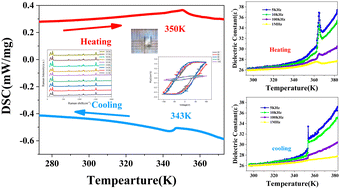A novel zero-dimensional organic–inorganic hybrid ferroelectric material†
Abstract
In recent years, organic–inorganic hybrid ferroelectric materials with zero-dimensional (0D) structures have attracted widespread attention due to their fascinating characteristics arising from isolated metal halide structures. However, the literature studies on 0D organic–inorganic hybrid materials remain relatively scarce, possibly due to challenges such as the uncontrollable growth of ferroelectric materials or other factors. In this study, we introduce a new 0D organic–inorganic hybrid ferroelectric material, (2-methylimidazole)2CdBr4, which undergoes a phase transition from a ferroelectric phase to a paraelectric phase (with space groups changing from P21 to P21/m) at 350 K during heating processes, with a spontaneous polarization of 0.35 μC cm−2. This work initiates with the structure of 0D organic–inorganic hybrid ferroelectric materials and discusses the material's ferroelectric, piezoelectric, and pyroelectric properties. Through this investigation, novel pathways for crafting 0D organic–inorganic hybrid ferroelectric materials are unveiled, along with insights into their potential applications across emerging material domains in the future.

- This article is part of the themed collection: 2024 Journal of Materials Chemistry C HOT Papers


 Please wait while we load your content...
Please wait while we load your content...